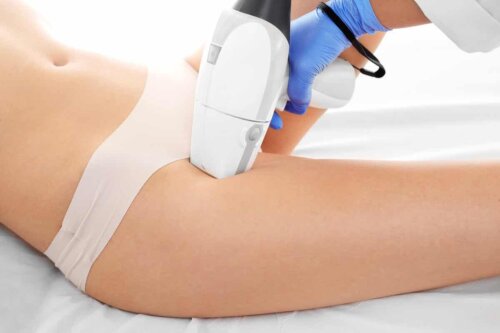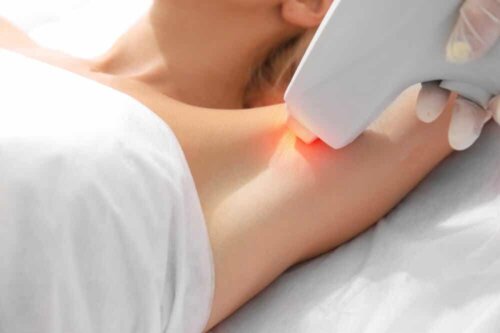Intense Pulsed Light Hair Removal: Everything You Need to Know

Intense pulsed light, also known as IPL, is a cosmetic hair removal treatment. People undergo it to minimize age spots, freckles, birthmarks, varicose veins, rosacea, and – of course – to remove unwanted hair.
This is one of the three methods classified as permanent hair removal. The other two are laser hair removal and electrolysis. However, IPL doesn’t offer permanent results, only fairly long-lasting ones.
Pulsed light hair removal is effective in inhibiting or weakening hair growth. It’s a safe photo epilation method that penetrates down to the second layer of the skin, or dermis, without damaging the superficial layer, or epidermis.
Let’s take a closer look.
How does intense pulsed light hair removal work?

Intense pulsed light hair removal is similar to laser hair removal but differs from it in the type of light it requires. While laser technology emits light with a single wavelength, this one delivers light with multiple wavelengths.
In other words, this method emits a soft, multi-colored light that expands or travels in different directions. It’s similar to a flash. In turn, a laser has a single color and focuses on a specific spot.
In both cases, a technician uses light to heat the hair follicles and prevent regrowth. The procedure begins with preparation, which consists of avoiding stimuli such as sunlight, tanning, chemical peeling, manual hair removal, collagen injections, creams, or products containing vitamin A and blood-thinning medications.
The actual procedure follows these steps:
- The application of anesthetic cream 30 to 60 minutes before the procedure
- Cleaning the area to work on
- The application of a cold gel to the skin
- Wearing dark glasses to protect the eyes
- The application of light to the area (this lasts from 20 minutes to a little over an hour, depending on the area)
- There may be stinging or redness for the next four to eight hours
- There may be swelling and it usually lasts for several days
- Finally, the treated area must be moisturized twice a day for the next three months
Find out Is Waxing a Good Hair Removal Practice?
The advantages of intense pulsed light hair removal
Pulsed light hair removal is a widely accepted treatment both for its simplicity and its durability. Its main advantages are as follows.
Personalized treatment
The device used for intense pulsed light hair removal can be adjusted to suit individual characteristics. It also takes into account the skin and hair properties. This treatment doesn’t necessarily require a specialist and people could do it at home but it isn’t recommended.
Types of hair
IPL is easily adaptable to hairs of varying volumes. It can effectively remove both fine and coarse ones. For instance, laser treatments require different types of treatment for every type of hair.
Area coverage
Each shot covers an area of 2 square inches. This is a large area compared to lasers that only cover specific points. Thus, it removes more hair in a shorter amount of time.
Little discomfort
IPL rarely causes pain. In most cases, every trigger only causes a mild sensation of warmth along with a gentle prick. This makes it easy to treat sensitive areas of the skin such as the groin, face, underarms, buttocks, etc.
Fast recovery
Side effects of this treatment are minimal. The discomfort of the procedure lasts only a few hours and side effects are rare. Recovery is fast as there’s no damage on the upper layers of the skin.
The disadvantages of intense pulsed light hair removal

As with any procedure, intense pulsed light hair removal also has limitations and drawbacks. The most relevant ones revealed in a photo epilation study are:
Light hair
Intense pulsed light hair removal isn’t as effective with light hair. In addition, it doesn’t remove gray hair because it lacks melanin. As a general rule, it is much more effective with dark-colored hair, especially if the skin is white and sharply contrasts with it.
Durability
Several treatments are necessary to obtain an optimal result. It’s also necessary to do one or two maintenance sessions per year. Furthermore, the treatment must be done by an experienced professional to obtain excellent results.
Possible risks
An improperly applied treatment will lead to hormonal spots. There’s also a risk of damage such as scarring, inflammation, bleeding, infection, color changes, hardening, or blistering.
Limitations
Intense pulsed light hair removal isn’t good for dark or tanned skin. In addition, it isn’t appropriate for children and teenagers, and pregnant or nursing women. In addition, this treatment isn’t good for certain skin conditions so always consult your doctor beforehand.
Cgeck out some Myths and Truths of Laser Hair Removal
Should you undergo intense pulsed light hair removal?
This technique is great for people who meet the conditions for optimal treatment. (That is, those with thick hair that contrasts with the color of their skin). The results are limited otherwise.
This procedure is usually expensive, so it’s important to make a thorough assessment in every case. There are other options such as laser treatment, Fraxel laser, and microdermabrasion.
As usual, consult a dermatologist if you have any questions or doubts.
All cited sources were thoroughly reviewed by our team to ensure their quality, reliability, currency, and validity. The bibliography of this article was considered reliable and of academic or scientific accuracy.
- Díaz-Martínez, L. A., Durán-Prada, M. L., & Mendoza-Pedrozo, J. P. (2015). La remoción por estética del vello púbico como causa de morbilidad inadvertida en la población general. Revista Argentina de Dermatología, 96(3), 40-6. http://www.scielo.org.ar/scielo.php?script=sci_arttext&pid=S1851-300X2015000300007
- Calderón, E. (2013). Eléctrica. Láser y Luz pulsada. Editorial Club Universitario. https://books.google.co.ve/books/about/El%C3%A9ctrica_L%C3%A1ser_y_Luz_pulsada.html?id=MNcyDwAAQBAJ&redir_esc=y
-
Gade, A., Vasile, G., Rubenstein, R. (2023). Intense Pulsed Light (IPL) Therapy. StatPearls Publishing. https://www.ncbi.nlm.nih.gov/books/NBK580525/
- Radmanesh, M., Azar-Beig, M., Abtahian, A., Naderi, A. H. (2008). Burning, paradoxical hypertrichosis, leukotrichia and folliculitis are four major complications of intense pulsed light hair removal therapy. The Journal of Dermatologic Treatment, 19(6), 360-3. https://pubmed.ncbi.nlm.nih.gov/18654911/
- Vélez, M. (2010). Fotodepilación: Áreas de difícil tratamiento. Cirugía Plástica Ibero-Latinoamericana, 36(2), 181-186. http://scielo.isciii.es/scielo.php?script=sci_arttext&pid=S0376-78922010000200013&lng=es
- Babilas, P., Schreml, S., Szeimies, R.-M., & Landthaler, M. (2010). Intense pulsed light (IPL): a review. Lasers in Surgery and Medicine, 42(2), 93–104. https://pubmed.ncbi.nlm.nih.gov/20166155/
- Town, G., & Ash, C. (2010). Are home-use intense pulsed light (IPL) devices safe? Lasers in Medical Science, 25(6), 773–780. https://pubmed.ncbi.nlm.nih.gov/20625788/
- Gan, S. D., & Graber, E. M. (2013). Laser hair removal: a review. Dermatologic Surgery, 39(6), 823–838. https://pubmed.ncbi.nlm.nih.gov/23332016/2
This text is provided for informational purposes only and does not replace consultation with a professional. If in doubt, consult your specialist.








